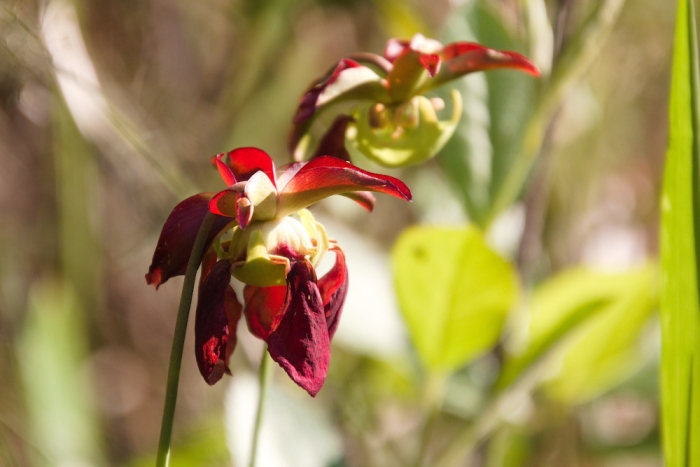Sweet Pitcher Plant
(Sarracenia rubra)
Sweet Pitcher Plant (Sarracenia rubra)
/
/

© psweet
CC BY-SA 4.0
Image By:
© psweet
Recorded By:
Copyright:
CC BY-SA 4.0
Copyright Notice:
Photo by: © psweet | License Type: CC BY-SA 4.0 | License URL: http://creativecommons.org/licenses/by-sa/4.0/ | Uploader: psweet | Publisher: iNaturalist |

























Estimated Native Range
Summary
Sarracenia rubra, commonly known as Sweet Pitcher Plant or Purple Pitcher Plant, is a perennial herbaceous carnivorous plant native to the longleaf pine savannas and pocosin bogs of the southeastern United States. It is particularly adapted to nutrient-poor, acidic, and waterlogged soils. This species typically grows to about 26 inches tall, with tubular, rolled leaves that form pitfall traps to capture and digest insects, a survival strategy in its nutrient-deficient environment. The leaves are often a striking red or green with red veins. In spring, it produces nodding, sweet-scented flowers with five red petals, which are quite showy and attract pollinators.
The Sweet Pitcher Plant is valued for its unique appearance and insect-trapping ability, making it a fascinating addition to bog gardens, water features, and as a natural pest control. It is often used in educational settings to demonstrate plant carnivory. In cultivation, it requires consistently moist to wet conditions, full sun to partial shade, and a soil mix that mimics its native boggy habitat, typically composed of peat and sand. It is important to avoid fertilizing and to use distilled water or rainwater to prevent mineral buildup. While generally disease-resistant, it can be susceptible to root rot if drainage is poor. Over-collection and habitat destruction have led to a decline in wild populations, so gardeners are encouraged to purchase from reputable nurseries that propagate plants responsibly.CC BY-SA 4.0
The Sweet Pitcher Plant is valued for its unique appearance and insect-trapping ability, making it a fascinating addition to bog gardens, water features, and as a natural pest control. It is often used in educational settings to demonstrate plant carnivory. In cultivation, it requires consistently moist to wet conditions, full sun to partial shade, and a soil mix that mimics its native boggy habitat, typically composed of peat and sand. It is important to avoid fertilizing and to use distilled water or rainwater to prevent mineral buildup. While generally disease-resistant, it can be susceptible to root rot if drainage is poor. Over-collection and habitat destruction have led to a decline in wild populations, so gardeners are encouraged to purchase from reputable nurseries that propagate plants responsibly.CC BY-SA 4.0
Plant Description
- Plant Type: Herb
- Height: 1-1.5 feet
- Width: 1-1.5 feet
- Growth Rate: Moderate, Rapid
- Flower Color: Green, Red, Yellow
- Flowering Season: Spring, Summer
- Leaf Retention: Deciduous
Growth Requirements
- Sun: Full Sun
- Water: Medium, High
- Drainage: Medium, Slow
Common Uses
Bird Garden, Butterfly Garden, Deer Resistant, Low Maintenance, Water Garden
Natural Habitat
Native to longleaf pine savannas and pocosin bogs in the southeastern United States
Other Names
Common Names: Sweet pitcher plant, Mountain Trumpets
Scientific Names: , Sarracenia rubra, Sarracenia media, Sarracenia media, Sarracenia minor,
GBIF Accepted Name: